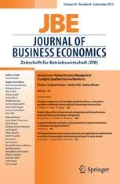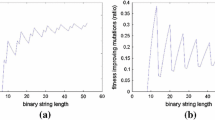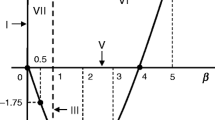Abstract
Suboptimal business decisions lead to corporate cost increases. The basis of the following study is a game theoretical model of Fandel and Trockel (Eur J Oper Res 226:85–93, 2013a), which analyses the relationship between bonuses and financial penalties in a three-person inspection game and the measures that counteract suboptimal decisions. In the present article we investigate from evolutionary perspectives whether the strategic behaviour of the actors described in an inspection game can be invaded by mutants and what risks emerge as a result. In a first step each of the three decision variables of the players will be discussed. It will become apparent that corporate optimal behaviour is realised when the actions of the business management or the controlling department are fixed. In a second step it will be shown that in games with three strategic variables mutations can undermine the solutions. In a third step we will investigate the model in consideration of monotonic payment and monotonic positive payment functions and divide the area of the solutions into octants to which we will allocate the influence of the mutations and demonstrate the circumstances under which a solution tending towards optimal corporate behaviour can be generated.






Similar content being viewed by others
References
Alexander JM (2009) Evolutionary game theory. In: Zalta EN (ed) The Stanford Encyclopedia of Philosophy, Stanford University, Stanford
Andreozzi L (2002) Oscillations in the enforcement of law: an evolutionary analysis. Homo Oeconom 18:403–428
Andreozzi L (2004) Rewarding policemen increases crime. Another surprising result from the inspection game. Public Choice 121:69–82
Andreozzi L (2010) Inspection games with long-run inspectors. Eur J Appl Math 21(4/5):441–458
Avenhaus R (2004) Applications of inspection games. Math Model Anal 9:179–192
Avenhaus R, Canty MJ (2011) Deterrence, technology, and the sensible distribution of arms control verification resources. Nav Res Logist 58:295–304
Avenhaus R, Krieger T (2011) Unannounced interim inspections: do false alarms matter? Math Model Anal 16:109–118
Axelrod R (1984) The evolution of cooperation. Basic Books, New York
Axelrod R (1986) An evolutionary approach to norms. Am Polit Scene Rev 80:1095–1111
Bettzuge MO, Hens T (2001) An evolutionary approach to financial innovations. Rev Econ Stud 68:493–522
Binmore K, Samuelson L (1994) An economist’s perspective on the evolution of norms. J Inst Theor Econ 150:45–63
Bomze IM, Burger R (1995) Stability by mutation in evolutionary games. Games Econ Behav 11:146–172
Chalub FACC, Santos FC, Pacheco JM (2006) The evolution of norms. J Theor Biol 241:233–240
Cressman R, Morrison WG, Wen JF (1998) On the evolutionary dynamics of crime. Can J Econ 31:1101–1117
Deutsch Y, Golany B, Rothblum UG (2011) Determining all Nash equilibria in a (bi-linear) inspection game. Eur J Oper Res 215:422–430
Dosi G, Nelson RR (2013) The evolution of technologies: an assessment of the state-of-the-art. Eurasian Bus Rev 3:3–46
Fandel G, Trockel J (2011a) Optimal lot sizing in a non-cooperative material manager–controller game. Int J Prod Econ 133:256–261
Fandel G, Trockel J (2011b) A game theoretical analysis of an extended manager-auditor-conflict. Zeitschrift für Betriebswirtschaft 81(4):33–53
Fandel G, Trockel J (2013a) Avoiding non-optimal management decisions by applying a three-person inspection game. Eur J Oper Res 226:85–93
Fandel G, Trockel J (2013b) Applying a one-shot and infinite repeated inspection game to materials management. CEJOR 21:495–506
Foster D, Young P (1990) Stochastic evolutionary game dynamics. Theor Popul Biol 38:219–232
Friedman D (1991) Evolutionary games in economics. Econometrica 59:637–666
Friedman D (1998) On economic applications of evolutionary game theory. J Evol Econ 8:15–43
Garcia J, Traulsen A (2012) The structure of mutations and the evolution of cooperation. PLoS One 7:e35287
Güth W, Kliemt H, Peleg B (2000) Co-evolution of preferences and information in simple games of trust. Ger Econ Rev 1:83–110
Hodgson GM, Huang K (2012) Evolutionary game theory and evolutionary economics: are they different species? J Evol Econ 22:345–366
Hofbauer J, Sigmund K (1988) The theory of evolution and dynamical systems. Cambridge University Press, Cambridge
Hohzaki R (2006) A compulsory smuggling model of inspection game taking account of fulfillment probabilities of players’ aims. J Oper Res Soc Jpn 49:306–318
Hohzaki R (2007) An inspection game with multiple inspectees. Eur J Oper Res 178:894–906
Hohzaki R (2011) An inspection game with smuggler’s decision on the amount of contraband. J Oper Res Soc Jpn 54:25–45
Hohzaki R (2012) A smuggling game with the secrecy of smuggler’s information. J Oper Res Soc Jpn 55:23–47
Hohzaki R, Maehara H (2010) A single-shot game of multi-period inspection. Eur J Oper Res 207:1410–1418
Hohzaki R, Masuda R (2012) A smuggling game with asymmetrical information of players. J Oper Res Soc 63:1434–1446
Hohzaki R, Kudoh D, Komiya T (2006) An inspection game: taking account of fulfillment probabilities of player’s aims. Nav Res Logist 53:761–771
Huck S, Kübler D, Weibull JW (2012) Social norms and economic incentives in firms. J Econ Behav Organ 83:173–185
Kolokoltsov V, Passi H, Yang W (2013) Inspection and crime prevention: an evolutionary perspective. Optim Control. http://arxiv.orgabs/1306.4219
Lu T, Sapra H (2009) Auditor conservatism and investment efficiency. Acc Rev 84:1933–1958
Mailath GJ (1992) Introduction: symposium on evolutionary game theory. J Econ Theor 57:259–277
Maynard Smith J, Price GR (1973) The logic of animal conflict. Nature 246:15–18
McGinty M (2010) International environmental agreements as evolutionary games. Environ Resour Econ 45:251–269
Metcalfe JS (1994) Evolutionary economics and technology policy. Econ J 104:931–944
Ohta Y (2008) On the conditions under which audit risk increases with information. Eur Acc Rev 17(3):559–587
Rowe GW (1985) Mutations, mixed strategies and game theory. J Theor Biol 117:291–302
Rubinstein A (1991) Comments on the interpretation of game theory. Econometrica 59:909–924
Samuelson L (1991) Limit evolutionary stable strategies in two-player, normal form games. Games Econ Behav 3:110–128
Samuelson L (1997) Evolutionary games and equilibrium selection. MIT Press, Cambridge
Samuelson L, Zhang J (1992) Evolutionary stability in asymmetric games. J Econ Theor 57:363–391
Selten R (1980) A note on evolutionarily stable strategies in asymmetric animal conflicts. J Theor Biol 84:93–101
Selten R (1983) Evolutionary stability in extensive two-person games. Math Soc Sci 5:269–363
Selten R (1988) Evolutionary stability in extensive two-person games—correction and further development. Math Soc Sci 16:223–226
Tarnita CE, Antal T, Nowak MA (2009) Mutation—selection equilibrium in games with mixed strategies. J Theor Biol 261:50–57
Trockel J (2013) Changing bonuses and the resulting effects of employees’ incentives to an inspection game. J Bus Econ 83:759–784
Van Damme E (1994) Evolutionary game theory. Eur Econ Rev 38:847–858
Weibull JW (1996) Evolutionary game theory. MIT Press, Cambridge
Weibull JW (1998) Evolution, rationality and equilibrium in games. Eur Econ Rev 42:641–649
Willensdorfer M, Nowak MA (2005) Mutation in evolutionary games can increase average fitness at equilibrium. J Theor Biol 237:355–362
Dresher M (1962) A sampling inspection problem in arms control agreement: a game theoretic analysis. In: RAND Memorandum, Memorandum No. RM-2972-ARPA. RAND Corporation, CA, Santa Monica
Yim A (2009) Efficient committed budget for implementing target audit probability for many inspectees. Manage Sci 55(12):2000–2018
Author information
Authors and Affiliations
Corresponding author
Appendix
Appendix
The calculation basis for the phase diagram in Fandel and Trockel’s three-person inspection model (2013a) for the manager is:
for the controller:
and for the corporate management:
If one now observes Eq. (34), \(\dot{p}_{m} = p_{m} \left( {1 - p_{m} } \right)\left( {p_{h} - p_{h}^{*} } \right)\left( {1 - p_{a} } \right)\left( {Q_{D} + B_{D} } \right)\), it must be recognised that the first, second and fourth multiplier in each case is greater than or equal to zero and the fifth multiplier is greater zero. For Eq. (34) this means that if in the third multiplier p h > p h * applies, the growth rate is \(\dot{p}_{m} > 0\) or that if the case p h < p h * applies, the growth rate is \(\dot{p}_{m} < 0\). By analogy one recognises by Eq. (36) that the first, second and fourth multiplier in each case is greater than or equal to zero and the fifth is greater zero. Thus for Eq. (36) it can be determined that if in the third multiplier p m < p m * applies, the growth rate \(\dot{p}_{h} > 0\), and vice versa. If one now considers Eq. (38) \(\dot{p}_{a} = p_{a} \left( {1 - p_{a} } \right)\left( {p_{m}^{*} - p_{m} } \right)\left[ {p_{h} B_{C + } \left( {1 - p_{h} } \right)\left( {B_{D} + Q_{D} } \right)} \right]\), it will be recognised that the first and the second multiplier in each case is greater than or equal to zero and the fourth multiplier is greater zero. For Eq. (38) this means that if in the third multiplier p m < p m * applies, the growth rate is \(\dot{p}_{a} > 0\), and vice versa.
Rights and permissions
About this article
Cite this article
Fandel, G., Trockel, J. The influence of mutations: an evolutionary inspection game with three strategic actors. J Bus Econ 84, 959–981 (2014). https://doi.org/10.1007/s11573-014-0734-4
Published:
Issue Date:
DOI: https://doi.org/10.1007/s11573-014-0734-4




